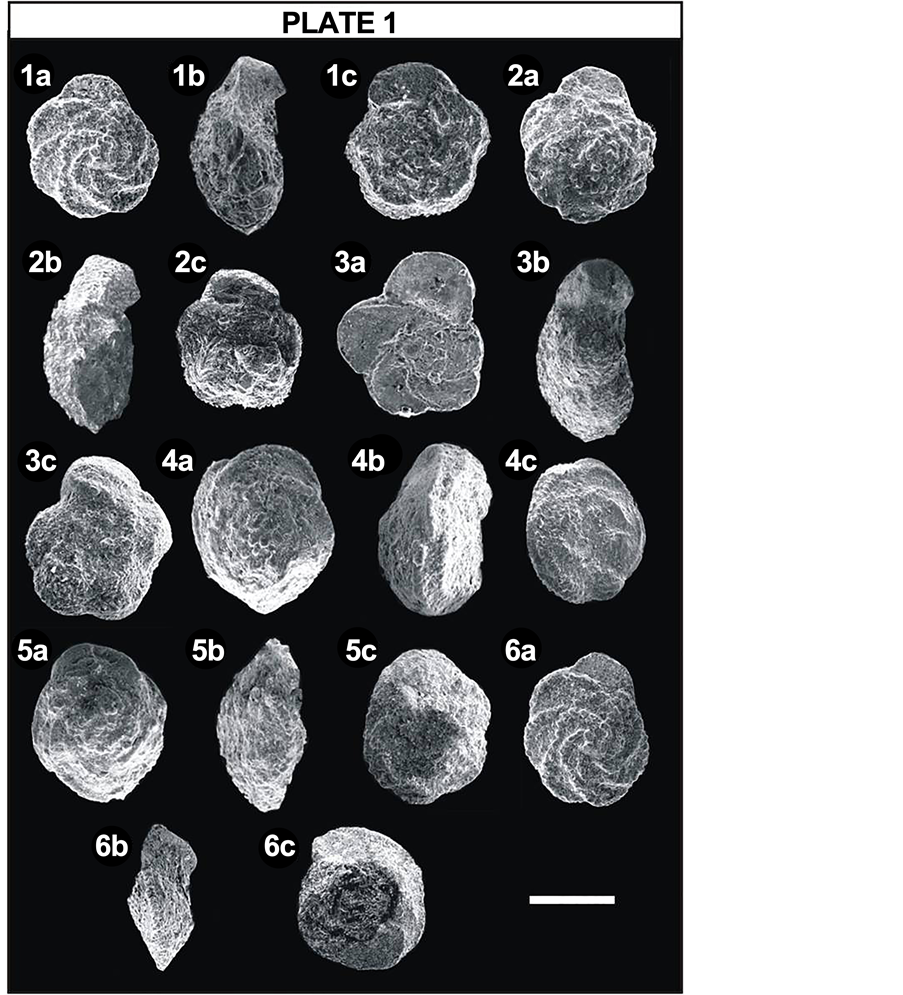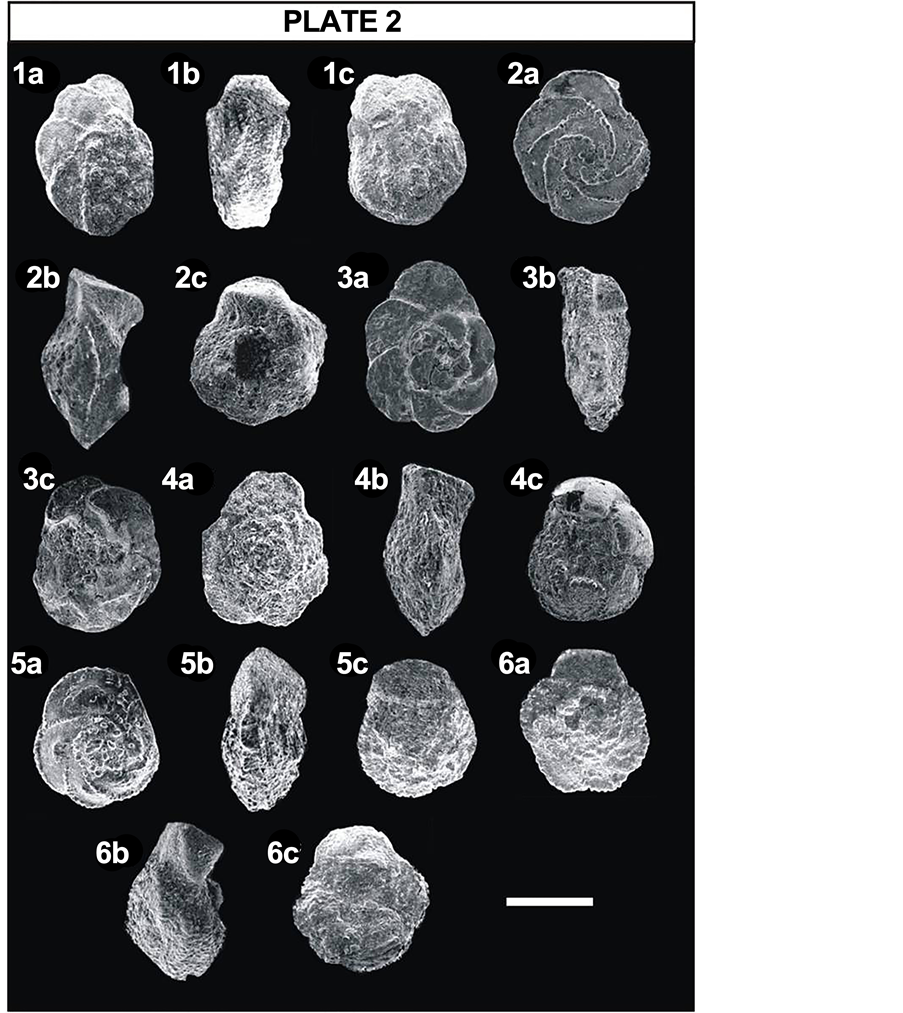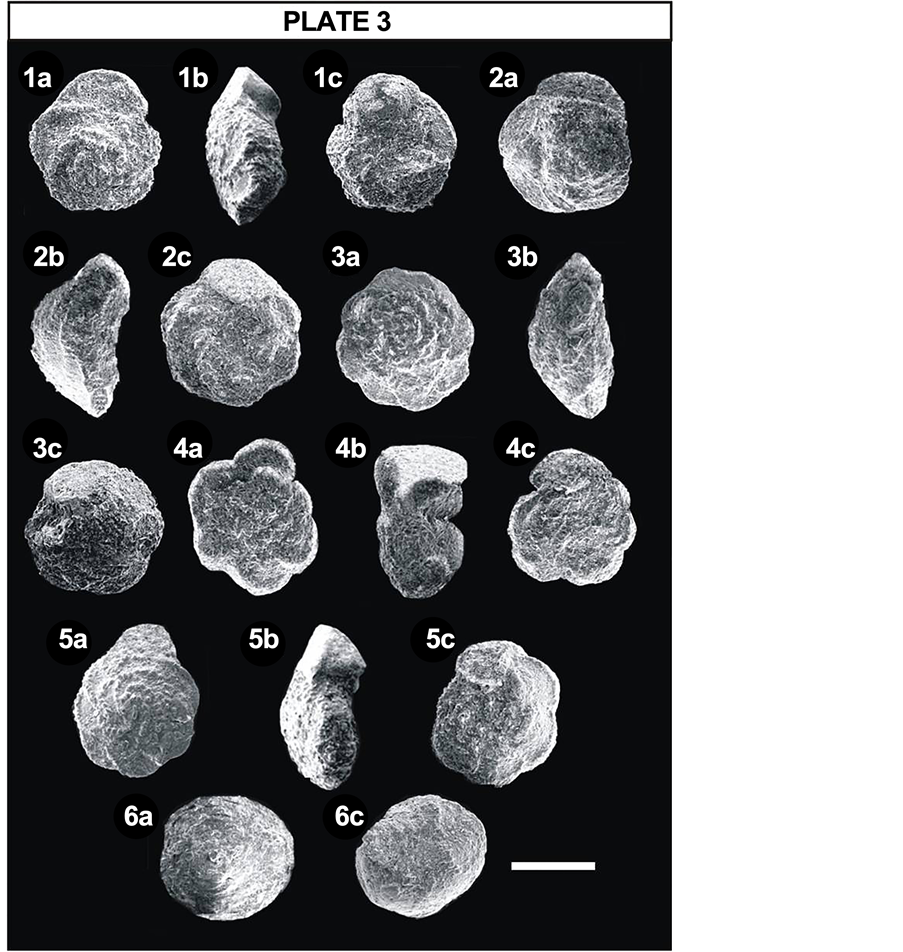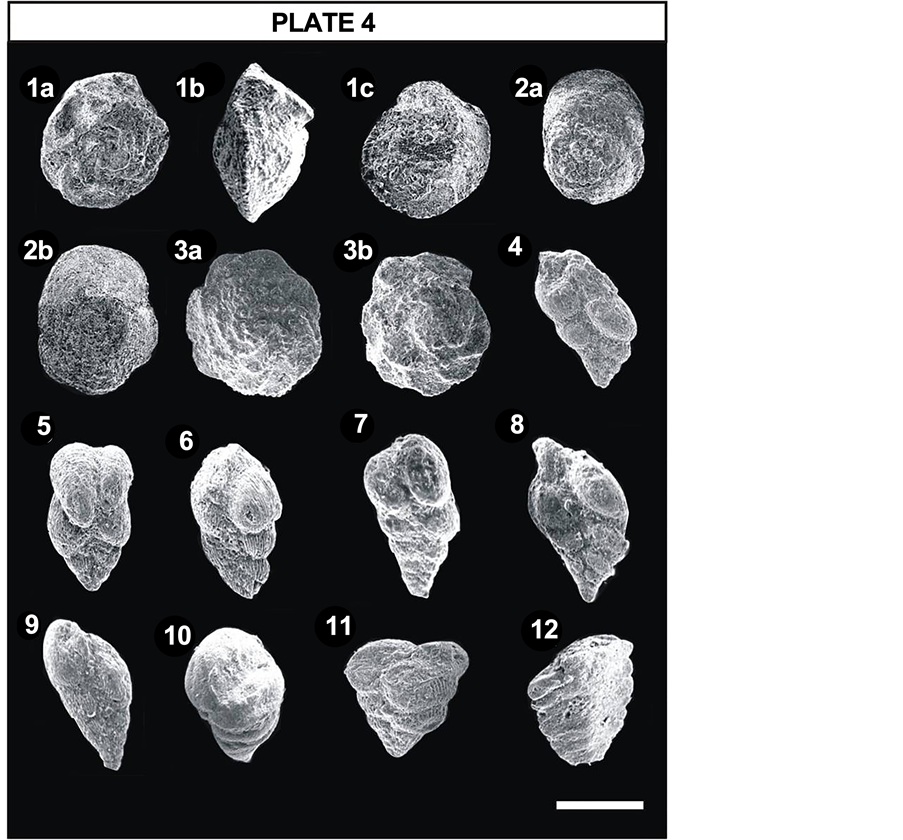Late Cretaceous Biostratigraphy Planktonic Foraminifera of the Farokhi Formation, Iran ()
1. Introduction
Central Iran continents have been divided into three parts such as Loot, Tabas and Yazd from east toward the west [1] [2] . The Farokhi Formation has been consisted of light grey limestone with chert and some echinoids and bivalves with high frequency. Lower parts of this formation were composed of marl and sandstone with 45 to 120 meters thickness.
This formation has out crop in Tabas Province. The studied section was placed at the west of Farokhi village. Farokhi Formation at type section has 65 - 180 meters thickness with light gray lime stone and chert with echinoids and bivalves with the high frequency and also based on brachiopoda, bivalves and echinoids, Late Senonian-Danian ages have been detected. [3] [4] studied Echinoids in Farokhi Formation and introduced Echinocorys ex.gr scutata. [5] , for the first time studied Dinocyst in the Farrokhi Formation. Also [6] investigated Farokhi Formation at khoor section, based on planktonic foraminifera and proposed Early-Late Maastrichtian.
[7] has found Porosphaera globularis (kind of sponge). [8] , based on benthic and planktonic foraminifera proposed Early Maastrichtian-Paleocene for the mentioned formation. [9] proposed Late Senonian-Paleocene for the studied formation based on Brachiopoda and Echinoids.
2. Geological Setting
The Tabas area is a part of the Central Iran sedimentary basin which is located in the Yazd Province. The Farokhi stratigraphic section is located 7 km northwest from Farokhi village (33˚54'9''N and 54˚52'48''E). The Bazyab, Debarso, Haftoman and Choopanan formations are well-exposed in the studied area. In this study, the Farokhi Formation is investigated in the Farrokhi stratigraphic section with regard to echinoids (Figure 1). The Farokhi Formation is mainly composed of thick-bedded limestones with Ammonoids, thin-bedded limestone with silicified echinoids and ichnofossils, marls with nodular cherts, spherical corals and bivalves.
3. Method
Totally twenty three samples were collected from studied area .Depending on their lithology, the samples were washed in two methods. The shale and marl samples were put in H2O2 10% for a day after being crushed into small pieces. The re-
![]()
Figure 1. Location of the studied section in NE Iran.
sidues were then washed with water on the screeners assigned with 125 and 63 µm meshes [10] .
Limestones were grid and boiled in Na2So4 solution then washed with water on the screeners assigned with the above mentioned meshes [11] .
First, all of samples were chopped to a crashed sediment and then took in H2O2 (10% molar) for 12 hours and then washed all of these sediments on the various number of sieves, respectively 63 µm and 125 µm (reframe). Finally, for separation of sediment and fossils, all of washed samples stayed in Ultrasonic Cleaner for 15 min and then they were washed again.
Ultimately, all sample residues remaining on mentioned sieves were studied and picked and then taken picture by Scanning Electron Microscope (SEM) in central laboratory of Ferdowsi University of Mashhad. All of SEM pictures in this manuscript were arranged in 4 plates as Appendix (Plates 1-4).
4. Lithostratigraphy of the Farokhi Formation at Type Section
Lithostratigraphy of the Farokhi Formation is in the study area. The upper and lower boundaries of the Farokhi Formation in the studied stratigraphic section are not observable because of the wide-spreading of formation in the area. From the lithological point of view, the Farokhi Formation in the studied area is mainly composed of the units as followed (Figure 2):
Thick-bedded, pinky limestone with fossil debris in some parts (50.50 m); Thin-bedded limestone with great amount of cherty echinoids and ichnofossils (18.50 m); Marls with great amount of cherty echinoids, nodular cherts, spherical corals and bivalves (22.50 m); Marls with reworked spherical corals (1.50 m). Marls with intercalations of shales and limestones with echinoids, spherical corals, colonial corals and bivalves (5.50 m); Marls (44 m); Marls without macrofauna, with secondary oxideveins and small joints (11 m); Marls (29.50 m); Marly limestone and limy marls (7.50 m); Hardened marls with coatings of iron oxide and no macrofauna (6 m); Dark limestone without any macrofauna (4.50 m); Limestones with ichnofossils, ammonoids and spherical corals (9.50 m); Pale limestones with ichnofossils and echinoids (5.50 m); Thin-bedded limestones with cherts and echinoids (11 m); Thin-bedded limestones with ichnofossils (4 m); Limestones with echinoids (9 m); Limestones with ichnofossils and partially compressed echinids (11 m); Limestones without any macrofauna (4 m).
5. Conclusion
Foraminifera, Latin, meaning hole bearers, (informally called “forams”) are members of a phylum or class of amoeboid protists characterized by streaming granular ectoplasm that among other things is used for catching food, and commonly by an external shell or “test” made of various materials and constructed in diverse forms. All but perhaps a very few are aquatic and most are marine, the majority of which live on or within the seafloor sediment (i.e., are benthic) while a smaller variety are floaters in the water column at various depths (i.e., are
![]()
Figure 2. Stratigraphic column of the Farokhi Formation in the studied area.
planktonic). A few are known from freshwater or brackish conditions and some soil species have been identified through molecular analysis of small subunit ribosomal DNA. Dying planktonic Foraminifera continuously rain down on the sea floor in vast numbers, their mineralized tests preserved as fossils in the accumulating sediment. Beginning in the 1960s, and largely under the auspices of the Deep Sea Drilling, Ocean Drilling, and International Ocean Drilling Programmers, as well as for the purposes of oil exploration, advanced deep-sea drilling techniques have been bringing up sediment cores bearing Foraminifera fossils. The effectively unlimited supply of these fossil tests and the relatively high-precision age-control models available for cores has produced an exceptionally high-quality planktonic Foraminifera fossil record dating back to the mid-Jurassic, and presents an unparalleled record for scientists testing and documenting the evolutionary process. The exceptional quality of the fossil record has allowed an impressively detailed picture of species inter-relationships to be developed on the basis of fossils, in many cases subsequently validated independently through molecular genetic studies on extant specimens.
6. Biozonation of Farokhi Formation
Diverse planktonic Foraminifera possessing wide stratigraphic range occur in abundance in most samples of the Farokhi Formation in the studied area. Nine genera and twenty eight species of planktonic Foraminifera were recognized. The zonal scheme presented here consists of 6 zones on the basis of the stratigraphic distribution of planktonic Foraminifera recognized in isolated specimens (Figure 3). Foraminiferal taxonomy and nomenclature of the identified taxa are followed after [12] - [17] . The planktonic foraminiferal zonation here used is compared in Figure 4 with other Tethyan biozonations [18] - [29] . This zonation is similar to that of Premoli-Silva and Verga, 2004.
Some of planktonic foraminifera that have been found at mentioned formation are as follows:
Abathomphalus sp., Contusotruncana contusa, Contusotruncana patelliformis, Dicarinella sp. Gansserina gansseri, Globigerinelloides sp., Globotruncana aegyptiaca, Globotruncana arca, Globotruncana bulloides, Globotruncana elevata, Globotruncana fornicata, Globotruncana lapparenti, Globotruncana linneiana, Globotruncana mariei, Globotruncana rugusa, Globotruncanita subspinosa, Globotruncana ventricosa, Globotruncanita atlantica, Globotruncanita conica, Globotruncanita stuarti, Globotruncanita stuartiformis, Marginotruncana pseudolinneiana, Marginotruncana sp.
The biozonation is as follows:
6.1. Globotruncanita Elevate Partial Range Zone
Definition: Interval from last occurrence of Dicarinella asymetrica to first occurrence of Globotruncana ventricosa.
Age: Early Campanian.
Partial range of the nominate taxon from the last appearance of Dicarinella asymetrica to the first appearance of Globotruncana ventricosa defines the zone. This Biozone was defined for the first time by Postuma (1971). The biozone is 11.5 meter thick and consists of grey dark, greyish to green and blue shale.
Important fossils recognized in this zone include:
Archaeoglobigerina blowi, Archeoglobigerina cretacea, Contusotruncana fornicata, Contusotruncana patelliformis, Globigerinelloides bollii, Globigerinel-
![]()
Figure 3. Distribution and planktonic foraminiferal zonation of the Farokhi Formation at type section.
![]()
Figure 4. Correlation of the proposed biostratigraphic zonal scheme at this study with other accepted standard biozones of other parts of the world.
loides prairiehillensis, Globigerinelloides multispina, Globigerinelloides ultramicra, Globotruncana arca, Globotruncana bulloides, Globotruncana lapparenti, Globotruncana linneiana, Globotruncana mariei, Globotruncana orientalis, Globotruncanita stuartiformis, Heterohelix globulosa, Heterohelix papula, Heterohelix punctulata, Heterohelix striata, Laeviheterohelix pulchera, Laeviheterohelix turgida, Pseudotextularia uttalli.
6.2. Globotruncana ventricosa Interval Zone
Definition: Interval from first occurrence of Globotruncana ventricosa to first occurrence of Radotruncana calcarata.
Age: Middle Campanian.
The biozone is 24 meter thick and it consists of grey to green shale, grey to light blue marl, and grey to dark blue marl. This zone was defined by Dalbiez, (1955) as the range of the nominate taxon between its first appearance to the first occurrence of Radotruncana calcarata.
Main fossils are recognized in this zone such as:
Archaeoglobigerina blowi, Archeoglobigerina cretacea, Contusotruncana fornicata, Contusotruncana patelliformis, Globigerinelloides prairiehillensis, Globigerinelloides ultramicra, Globotruncana arca, Globotruncana bulloides, Globotruncana hilli, Globotruncana lapparenti, Globotruncana linneiana, Globotruncana mariei, Globotruncana orientalis, Globotruncanita elevata, Globotruncanita stuartiformis, Heterohelix globulosa, Heterohelix punctulata, Heterohelix striata, Laeviheterohelix pulchera, Pseudotextularia nuttalli.
6.3. Globotruncanita stuartiformis Partial-Range Zone
Age: Middle Campanian.
Partial range of the nominate taxon from the last appearance of Globotruncana ventricosa to the first appearance of Globotruncana aegyptiaca defines the zone. This Biozone was defined for the first time by [30] . The biozone is 22.5 meter thick and consists of grey dark, greyish to green and blue shale.
Main fossils are recognized in this zone such as:
Globotruncanita stuartiformis (Dalbiez), Archaeoglobigerina blowi Pessagno, Archaeoglobigerina cretacea (d’Orbigny), Contusotruncana fornicata (Plummer), Heterohelix planata (Cushman), Macroglobigerinelloides bollii (Pessagno), Globotruncana falsostuarti Sigal, Globotruncana orientalis El-Naggar, Globotruncana mariei Banner & Blow, Globotruncanella havanensis (Voorwijk), Globotruncana linneiana (d’Orbigny), Globotruncana ventricosa (White), Globotruncanita stuartiformis (Dalbiez), Globotruncanita stuarti (de Lapparent), Globotruncana arca (Cushman), Globotruncana bulloides Volger, Globotruncana lapparenti Brotzen, Pseudotextularia nuttalli (Voorwijk), Rugoglobigerina rugosa (Plummer).
6.4. Globotruncana aegyptiaca Interval Zone
Definition: Interval from first occurrence of Globotruncana aegyptica to first occurrence of Ganserina gansseri.
Age: late Campanian.
The biozone is 15.5 meter thick and it consists of grey to light green shale and grey to light green silty shale. The range of this biozone was introduced by Bronnimann in 1952 from the first occurrence of Globotruncana aegyptica to first occurrence of Gansserina gansseri. This biozone has late Campanian age.
Main fossils are recognized in this zone are:
Globotruncana aegyptiaca Caron, Contusotruncana fornicataa (Plummer), Heterohelix planata (Cushman), Heterohelix globulosa (Ehrenberg), Muricohedbergella monmouthensis (Olsson), Globotruncana arca (Cushman), Globotruncana bulloides Volger, Globotruncana falsostuarti Sigal, Globotruncana ventricosa (White), Globotruncanita stuartiformis (Dalbiez), Globotruncana linneiana (d’Orbigny), Globotruncana lapparenti Brotzen, Globotruncana orientalis El-Naggar, Globotruncana mariei Banner & Blow, Globotruncanita stuarti (de Lapparent), Globotruncanella havanensis (Voorwijk), Pseudotextularia nuttalli (Voorwijk).
6.5. Gansserina gansseri Interval Zone of Premoli Silva & Bolli (1973)
Definition: Interval from first occurrence of Ganserina gansseri to first occurrence of Contusotruncana contusa.
Age: late Campanian-Early Maastrichtian.
The biozone is 14 meter thick and it consists of grey to light green shale and grey to light green silty shale. The range of this biozone was introduced by Bron- nimann in 1952 from the first occurrence of Ganserina gansserito and first occurrence of Contusotruncana contusa. This biozone has late Campanian age.
Main fossils are recognized in this zone are:
Gansserina gansseri (Bolli), Archaeoglobigerina blowi Pessagno, Globotruncana falsostuarti Sigal, Contusotruncana fornicataa (Plummer), Contusotruncana patelliformis (Gandolfi), Contusotruncana plicata (White), Contusotruncana plummera (Gandolfi), Heterohelix punctulata (Cushman), Heterohelix globulosa (Ehrenberg), Muricohedbergella monmouthensis (Olson), Globotruncana orientalis El-Naggar, Globotruncana mariei Banner & Blow, Globotruncana lapparenti Brotzen, Globotruncana arca (Cushman), Globotruncana bulloides Volger, Globotruncana ventricosa (White), Globotruncanita stuartiformis (Dalbiez), Globotruncanita stuarti (de Lapparent), Rugoglobigerina rugosa (Plummer).
6.6. Contusotruncana contusa Interval Zone (Premoli Silva & Bolli, 1973)
Definition: Interval from first occurrence of Contusotruncana contusato and first occurrence of Abathomphalus mayaroensis
Age: Early-Late Maastrichtian.
The biozone is 7.5 meter thick and it consists of grey to light green shale and grey to light green silty shale. The range of this biozone was introduced by Bronnimann in 1952 from the first occurrence of Ganserina gansserito first occurrence of Contusotruncana contusa. This biozone has late Campanian age.
Main fossils are recognized in this zone are:
Contusotruncaca contusa (Cushman), Archaeoglobigerina blowi Pessagno, Contusotruncana fornicata (Plummer), Gansserina gansseri (Bolli), Globotruncana orientalis El-Naggar, Globotruncana mariei Banner & Blow, Globotruncana lapparenti Brotzen, Globotruncana arca (Cushman), Globotruncana bulloides Volger, Globotruncana ventricosa (White), Globotruncanita stuartiformis (Dalbiez), Globotruncanita stuarti (de Lapparent), Globotruncanella havanensis (Vo- orwijk), Pseudotextularia elegans (Rzehak), Pseudotextularia intermedia deKlasz, Pseudotextularia nuttalli (Voorwijk), Rugoglobigerina rugosa (Plummer).
At last in view of late research, Early Campanian-Late Maastrichtian ages for this formation have been recorded.
7. Result
Farokhi Formation has been studied at type section in Central of Iran. Twenty eight planktonic foraminifer species belonging to 8 genera in frame of 6 biozones have been recorded as below:
1) Globotruncanita elevata Partial Range Zone. 2) Globotruncana ventricosa Interval Zone. 3) Globotruncanita stuartiformis Partial Range Zone. 4) Globotruncana aegyptiaca Interval Zone. 5) Gansserina gansseri Interval Zone. 6) Contusotruncana contusa Interval Zone.
Based on this research Early Campanian-Maastrichtian ages were detected of mentioned studied section. Finally all of realized biozones in this research have been compared with main Tyetyan biozonation scheme in the world and all of zones which were identified for Farokhi Formation at type section resembles with [17] biozonation.
Appendix

Plate 1. 1a, 1b and 1c: Globotruncana arca; 2a, 2b and 2c: Globotruncana cf.arca; 3a, 3b and 3c: Globotruncana cf. marie; 4a, 4b and 4c: Contusotruncana cf. fornicata; 5a, 5b and 5c: Contusotruncana cf. patelliformis; 6a, 6b and 6c: Globotruncanitaelevata. Scale bar represent 100 micrometers.

Plate 2. 1a, 1b and 1c: Globotruncana cf. ventricosa; 2a, 2b and 2c: Globotruncanitaelevata; 3a, 3b and 3c: Globotruncana lapparenti; 4a, 4b and 4c: Globotruncanita stuartiformis; 5a, 5b, and 5c: Globotruncana orientalis; 6a, 6b and 6c: Globotruncana oblique. Scale bar represent 100micrometers.

Plate 3. 1a, 1b and 1c: Globotruncana cf linneiana; 2a, 2b and 2c: Globotruncanaconica, 3a, 3b and 3c: Globotruncana cf dupableie; 4a, 4b and 4c: Gansserina gansseri; 5a, 5b and 5c: Globotruncana cf. arca; 6a and 6c: Contusotruncana cf contusa. Scale bar represent 100 micrometer.

Plate 4. 1a, 1b and 1c: Globotruncanita stuarti; 2a and 2b: Globotruncana aegyptiaca; 3a and 3b: Globotruncana sp; 4: Heterohelix globulosa; 5 and 6: Heterohelix striata; 7: Heterohelix moremani; 8: Laeviheterohelix pulchra; 9: Heterohelix reussi; 10: Pseudotextularia nuttalii; 11 and 12: Pseudotextularia elegans. Scale bar represent 100 micrometer.